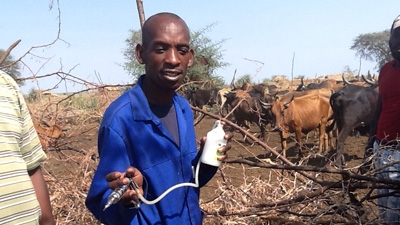SESHEKE, April 16, 2014 – In Shesheke, in western Zambia, cattle rearing is more than just a livelihood; it is a culture that can be threatened by the spread of animal diseases, affecting the lives of poor people who depend on them. With cattle sharing watering holes with buffalo, particularly during the dry season, herds are especially at risk for contracting Foot and Mouth Disease (FMD).
To prevent an outbreak of FMD and other animal diseases in the country, the Department of Veterinary Services in the Ministry of Agriculture and Livestock (MAL) has set up vaccination centers throughout the province. The centers were created through the $50 million Livestock Development and Animal Health Project (LDAHP) supported by the World Bank.
“We are excited that this program has taken off,” said Dr. W. Chikanya, Sesheke district veterinary officer. He explained that FMD vaccination is carried out on an annual basis to keep the disease incidence to zero.
The fight against FMD is confined to rural areas that come in contact with wildlife such as in Sesheke, Namwala, Kazungula, Livingstone and Monze in Southern Province and Itezhi Tezhi and Mumbwa in Central Province. Other areas include Nakonde and Mbala which do not border a national park, but are vaccinated due to the threat of disease originating from Tanzania. The project’s focus areas include Eastern, Central, parts of Copperbelt, and Southern and Western provinces where 80% of cattle belonging to smallholder farmers can be found.
Although no incidences of FMD have been reported in Zambia in recent years, an outbreak of FMD results in huge economic losses to all farmers because trade is restricted as the movement of animals and there products to and from the affected areas is banned. If the ban on the movement of livestock lasts months or even years as has been the case in the past, farmers’ livelihoods and incomes are destroyed.
According to the World Organization for Animal Health (OIE), FMD is a highly contagious viral disease affecting cloven-hoofed animals and that can cause severe economic losses. FMD is a notifiable disease and vaccination of all animals at risk in defined buffer zones is the most effective method of control. .
The livestock sector contributes approximately 39% percent to rural incomes in Zambia, making the control of FMD and other diseases and their vectors a critical priority. The country is already faced with the challenge of low productivity in the livestock sector due to underinvestment, poor animal husbandry and poor animal nutrition.
Alex Mwanakasale, the task team leader for the LDAHP, said $25 million has been allocated to strengthening veterinary services including surveillance, laboratory diagnostic capacity, control of animal diseases and institutional support to the livestock and agriculture ministry. “It is important to bring animal diseases under control as a prerequisite for productivity improvements,” he said.
Zambia’s long term livestock sector strategy is to establish a Disease-Free Zone as defined by the OIE, with the objective of accessing international markets for livestock and meat products.
LDAHP is also supporting capacity strengthening of key public institutions in the livestock sector, with the specific objective of improving delivery of advisory and technical services to enhance the adoption of good husbandry practices and innovative technologies, and promote sustainable development of the livestock sector.

